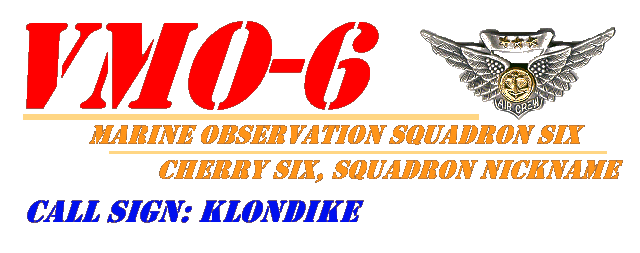

Marine Observation Squadron Six (VMO–6) was established as an active aviation unit on 20 November 1944 at Quantico, Virginia. After a short training and qualification period with the OY–1 observation aircraft, the squadron was transferred to Camp Pendleton California to train with the 6th Marine Division, which was formed at this time.
On 26 January 1945, the squadron departed for Guadalcanal in the Solomon Islands. Additional training was accomplished and the unit completed staging for its participation in the operation to seize Okinawa. Shortly after D–Day (1 April) 1945, VMO–6 moved ashore and began operations from Yantan Airstrip which was captured from the Japanese. During the battle for Okinawa, VMO–6 flew twelve OY–1 aircraft on a variety of missions. These missions included artillery spotting, message pick-ups, photo reconnaissance and the evacuation of wounded in litter equipped OY’s.
VMO–6 participated in the battle of Okinawa until its conclusion on 21 June 1945. The squadron was awarded its first Presidential Unit Citation for its accomplishments during the Okinawa operations as well as the Asiatic Medal with one battle star.
On 8 July 1945, the squadron departed for NAS Agana, Guam, where it remained until deployment to North China on 12 October 1945. This was a peacetime occupation and was ended by the southward push of the Chinese Communist Forces. VMO–6 was awarded the China Service medal for its service in North China.
VMO–6 returned to the United States and practically disappeared into the hills of Camp Pendleton until July of 1950. Chappo Flats has been the home of VMO–6 between its tours of duty overseas. The call came again.
With the addition of HO3S–1 helicopters and pilots of HMX–1 at Quantico, Virginia VMO–6 became the first active Combat Helicopter Unit in the United States Marine Corps when it departed for the Far East on 14 July 1950 VMO–6 arrived in Kobe, Japan with four HO3S–1 Sikorsky Helicopters and eight OY–1 fixed wing aircraft. The unit staged through Itami, Air Base, Japan to Korea.
Almost immediately VMO–6 began making a name for itself. The command capability of the helicopters was tried and proven with great success. The OY’s flew convoy escort for the First Marine Brigade as well as observation and reconnaissance missions. On 4 August 1950, VMO–6 flew its first casualty and was followed by an ever increasing number of "evacs" from day to day. Captain Victor A. Armstrong flew the first night Evac of the Korean War.
VMO–6 continued to operate successfully in Korea, flying dawn to dusk reconnaissance flights, rescue evacuations and artillery spotting in Support of the 1st Marine Brigades attacks and counter attacks. VMO–6 received their new observation aircraft, the OE–1s late in 1951. About the same time they replaced the HO3S’s with the HTL–4 Bell helicopters. Then in July 1952 the squadron received twelve HO5S–1 Sikorsky helicopters.
During the thirty–five months of combat in Korea, VMO–6 flew a total of 7,065 wounded men with serious wounds, classified as emergency "EVACS" these casualties were flown to various field hospitals and hospital ships.
VMO–6 was awarded its second Presidential Unit Citation for its action in Korea along with the Korean Presidential Unit Citation, the Navy Unit Commendation Medal and the Korean Service medal with five battle stars.
In March of 1955, VMO–6 was ordered back to the states. The Squadron arrived at NAS North Island, San Diego, California, and proceeded on up to Camp Pendleton. On 22 April 1955, the squadron was once again at Chappo Flats Airstrip.
VMO–6 received replacements for the OE–1s, the more powerful super charged OE–2 Cessna in the summer of 1955. Then about a year later in April of 1956, the first two HOK’s arrived at the squadron, replacing the tired out and under powered HO5s. These were the squadron’s aircraft until August 1964. The new gas turbine UH–1E "HUEY" made its appearance over the skies of Camp Pendleton.
VMO–6 remained at Camp Pendleton supporting the First Marine Division, training pilots, observers, crew chiefs, mechanics, and all personnel it takes to make up a fighting outfit. Ready to go if they were needed. And They Were NeededÖ..
VMO–6 again left for war. Leaving Long Beach, California 11 August 1965. They arrived at Chu Lai Republic of Vietnam (RVN) on 1 September, 1965. There was a brief indoctrination with the Army at Da Nang, then the squadron began operating out of Ky Ha airstrip at Chu Lai. VMO–6’s call sign "Klondike" soon became known throughout South Vietnam.
During the fiscal year 1967 VMO–6 won the CNO Safety Award for the second year in a row, thus bringing their total accident free hours to 40,773. An all time high for VMO squadrons was attained with 16,468 hours, 35,321 sorties, and 10,643 combat missions flown.
VMO–6 continued to distinguish themselves in combat support operations throughout the I Corps area. The squadron kill record soared to 806 confirmed kills. The "Huey" gunships escorted 3,623 medical evacuation missions. The "Huey" slicks carried 1,345 medevacs.
This web page is dedicated to all the men who were there...